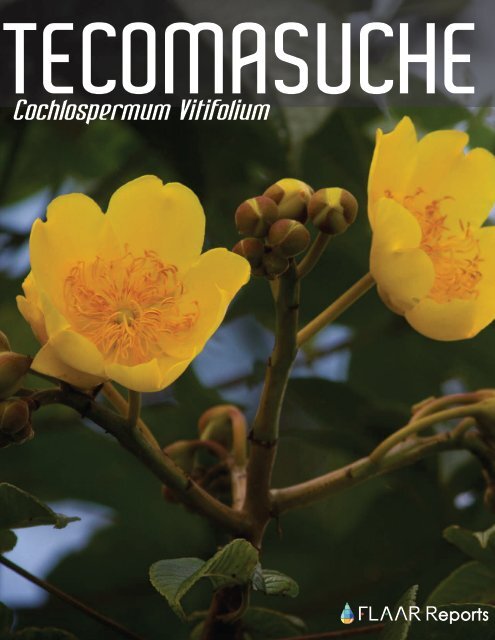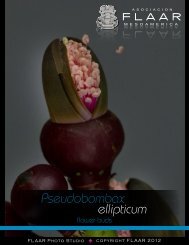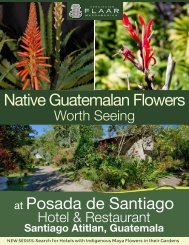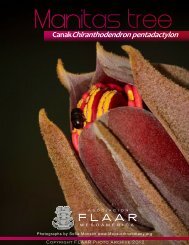Cochlospermum Vitifolium - Maya Ethnobotany
Cochlospermum Vitifolium - Maya Ethnobotany
Cochlospermum Vitifolium - Maya Ethnobotany
Create successful ePaper yourself
Turn your PDF publications into a flip-book with our unique Google optimized e-Paper software.
<strong>Cochlospermum</strong> <strong>Vitifolium</strong>
Photo: Sofia MonzónCochlosperum vitifolium
Tecomasuche TreeTecomasuche, Coclospermum vitifoliumsurrounding Copan Sculpture MuseumDuring mid-April we spent several days photographing all notable floweringtrees around Copan Ruinas, Honduras which are of significance for studies of<strong>Maya</strong> ethnobotany. Over the last five years we have built up a reference photoarchive of perhaps 35,000 high-res images of utilitarian and sacred plants ofGuatemala (and some of El Salvador). Since the <strong>Maya</strong> culture extended intoHonduras, we felt it would be useful to expand our photography to Honduras.We will donate copies of our photography to IHAH. And we give away ourpublications at no cost to students, scholars, and interested lay people.There was a Tecomasuche tree, <strong>Cochlospermum</strong> vitifolium in front of theentrance to the Copan Sculpture Museum still giving some flowers, so wephotographed this with our telephoto and tele-macro lenses with a 21megapixel Canon camera.Tecomasuche, <strong>Cochlospermum</strong> vitifolium :photo sessions in past yearDuring the last two years we have noticed Tecomasuche,<strong>Cochlospermum</strong> vitifolium flowering throughout Guatemala.It is a relatively common tree in several d epartamentos ofGuatemala. We show samples of those photographs on ourweb site www.maya-ethnobotany.org.Photo: Sofia Monzón
Photo equipment utilized at Copan tophotograph the Tecomasuche flowersand fruitsThere were only a few flowers and seed pods remaining. Inanother week or so the green seed pods will mature and thecotton-like fiber will become visible as the pod opens.To photograph the Tecomasuche, <strong>Cochlospermum</strong> vitifoliumat Copan we used a tall Gitzo tripod, a Canon flash, and a telephotoflash adapter. This adapter throws the flash in a narrowbeam so it can reach the flowers and fruits high up in the tree.Most normal flash, by itself, can adequately illuminate thingsfar away.Since it was very windy this week, even with a high ISO it wastough to freeze the flowers and fruits perfectly, but we did thebest we could with a reasonable speed.Photo: Sofia Monzón
Tecomasuche TreeBibliography on uses ofTecomasuche, <strong>Cochlospermum</strong>vitifoliumIn the excellent photographic resource, Campecheen Flor, Anibal Niembro-Rocas, the yellow<strong>Cochlospermum</strong> vitifolium flowers are pictured onpage 89 (but not the characteristic seed pod). Theauthor states that a colorant for textiles can beobtained (but she does not say from which part of thetree).Of Arboles de Costa Rica, I have only Vol. III whereCoclospermum vitifolium is not present.In the third edition of Plantas ornamentales nativasde Costa Rica (Barry Hammel), <strong>Cochlospermum</strong>vitifolium is listed (with one single photo) but is notdescribed and the seed pod again is not illustrated.Tecomasuche is evidently not a name used in CostaRica. They call it the Buttercup tree, or poro-poro.Trees of Guatemala (Parker 2008) discusses<strong>Cochlospermum</strong> vitifolium on page 172. She pointsout the “cotton” content of the seed pod, andmentions that it is called Mountain Cotton, or in Belize“Cotton Tree.”The tree is stated to be easy to transplant and flowerswithin a year or so. I have seen flowers at many timesof the year (in different locations).Parker adds that the bark can be used as cordageand that parts of the tree are used for local medicinalpurposes.
AdditionalBibliographyOne opus is particularly pertinent.Paul R. House, Instituto Regional deBiodiversidad, IRBio, prepared a 26page report in 2007 on Ethnobotanica<strong>Maya</strong>, Parque Arqueologico Ruinas deCopan (available on-line, as PDF).He makes complete lists of every kindof tree or food crop for the area. Ifyou are interested in the completeethnobotany of the Copan area, hislists are very important.
How FLAAR can contribute is to provide high-resolutionphotographs of the different plants. Obviously only afew flowers are blooming each month, and each year theflowering season varies depending on the weather thatyear. So it takes about three years of field trips to find andphotograph most species in any one area.The field trip of April was intended to show thephotographic capability of the FLAAR team to aidbotanical studies in Honduras. If funds become available,we would enjoy contributing photographs of all the otherpertinent species.First posted April 2012









